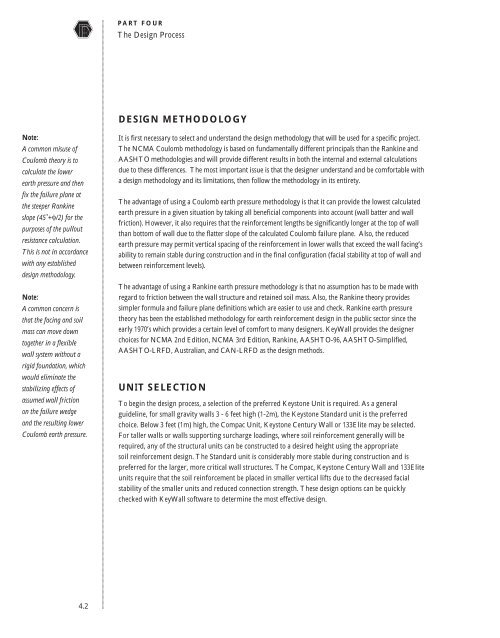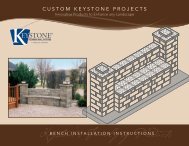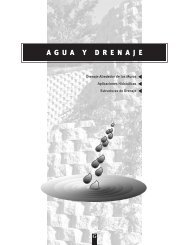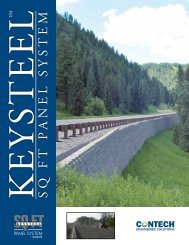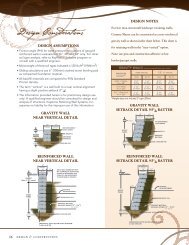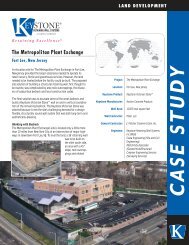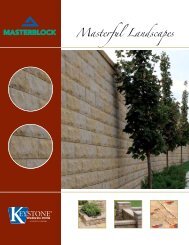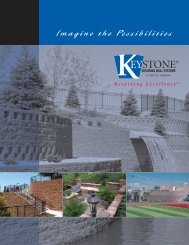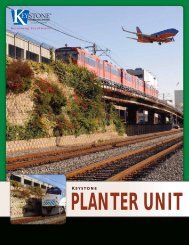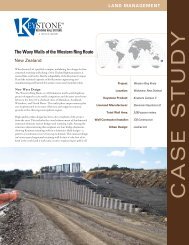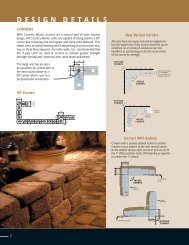Download - Keystone
Download - Keystone
Download - Keystone
Create successful ePaper yourself
Turn your PDF publications into a flip-book with our unique Google optimized e-Paper software.
PART FOURThe Design ProcessDESIGN METHODOLOGYNote:A common misuse ofCoulomb theory is tocalculate the lowerearth pressure and thenfix the failure plane atthe steeper Rankineslope (45˚+φ/2) for thepurposes of the pulloutresistance calculation.This is not in accordancewith any establisheddesign methodology.Note:A common concern isthat the facing and soilmass can move downtogether in a flexiblewall system without arigid foundation, whichwould eliminate thestabilizing effects ofassumed wall frictionon the failure wedgeand the resulting lowerCoulomb earth pressure.It is first necessary to select and understand the design methodology that will be used for a specific project.The NCMA Coulomb methodology is based on fundamentally different principals than the Rankine andAASHTO methodologies and will provide different results in both the internal and external calculationsdue to these differences. The most important issue is that the designer understand and be comfortable witha design methodology and its limitations, then follow the methodology in its entirety.The advantage of using a Coulomb earth pressure methodology is that it can provide the lowest calculatedearth pressure in a given situation by taking all beneficial components into account (wall batter and wallfriction). However, it also requires that the reinforcement lengths be significantly longer at the top of wallthan bottom of wall due to the flatter slope of the calculated Coulomb failure plane. Also, the reducedearth pressure may permit vertical spacing of the reinforcement in lower walls that exceed the wall facing’sability to remain stable during construction and in the final configuration (facial stability at top of wall andbetween reinforcement levels).The advantage of using a Rankine earth pressure methodology is that no assumption has to be made withregard to friction between the wall structure and retained soil mass. Also, the Rankine theory providessimpler formula and failure plane definitions which are easier to use and check. Rankine earth pressuretheory has been the established methodology for earth reinforcement design in the public sector since theearly 1970’s which provides a certain level of comfort to many designers. KeyWall provides the designerchoices for NCMA 2nd Edition, NCMA 3rd Edition, Rankine, AASHTO-96, AASHTO-Simplified,AASHTO-LRFD, Australian, and CAN-LRFD as the design methods.UNIT SELECTIONTo begin the design process, a selection of the preferred <strong>Keystone</strong> Unit is required. As a generalguideline, for small gravity walls 3 - 6 feet high (1-2m), the <strong>Keystone</strong> Standard unit is the preferredchoice. Below 3 feet (1m) high, the Compac Unit, <strong>Keystone</strong> Century Wall or 133Elite may be selected.For taller walls or walls supporting surcharge loadings, where soil reinforcement generally will berequired, any of the structural units can be constructed to a desired height using the appropriatesoil reinforcement design. The Standard unit is considerably more stable during construction and ispreferred for the larger, more critical wall structures. The Compac, <strong>Keystone</strong> Century Wall and 133Eliteunits require that the soil reinforcement be placed in smaller vertical lifts due to the decreased facialstability of the smaller units and reduced connection strength. These design options can be quicklychecked with KeyWall software to determine the most effective design.4.2


